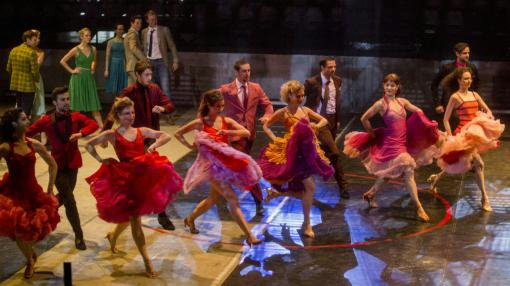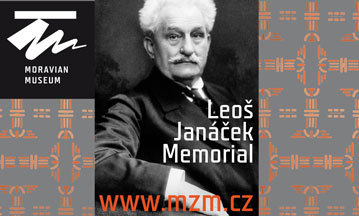Yesterday the biggest hall of the Brno Exhibition Centre – Pavilion P – was filled with an audience of a thousand. The premiere of the ballet West Side Story was completely sold out. The performance was given by the National Theatre Brno, the author of the original concept and also the original choreography is Jerome Robbins, the libretto is by Arthur Laurents, the music from Leonard Bernstein and the song lyrics by Stephen Sondheim. The Brno performance of this world-famous musical was directed by Mário Radačovský, who also created the choreography for this new production. The sets were designed by Marek Hollý and the costumes by Alexandra Grusková. The lighting design was by Tomáš Morávek while the projection was directed by Jan Fuksa and Martin Svobodník.
The role of Maria was played by Taela Williams, Anita by Ivona Jeličová, Maria’s suitor Tony by Arthur Abram, the leader of the Sharks, Bernard, by Martin Svobodník and the head of the Jets by Ivan Popov. The Jets and the Sharks and their girls were danced by the soloists and corps de ballet of the NdB Ballet (National Theatre Brno Ballet). The music was from a recording made by Leonard Bernstein himself in 1985. On the recording Kiri Te Kanawa and José Carreras sang alongside Tatiana Troyanos, Marilyn Horne, Kurt Ollman and others.
The story of the musical West Side Story draws its inspiration from Shakespeare’s Romeo and Juliet. Two opposed gangs go for each other’s throats without reason as if they had dropped out of the Verona of the 16th century. These unfortunate lovers find themselves in the wrong time and place hope for a future far from unnecessary bravado and violence – a tale as old as art itself. West Side Story itself is set in the New York of the 1950s. A time when the country had once more begun to live the American dream and had again begun to attract countless immigrants seeking their place there. For many of them America represented a true Eldorado. How bleak and distant all dreams of wealth seemed, however, when meeting with the hidden face of America – street gangs, racism and corrupt police. Anyone wanting to succeed in this unfriendly environment has to show their teeth and maybe even bite.
The ballet production of Mário Radačovský is conceived as a contest. The battlefield of the performance, as in the film, is a basketball court. The initial sparring of local young bloods soon escalates into open hostilities. Viewers from the opposing sides watch this conflict in the oblong arena, giving it even more the feel of a sporting encounter. Billboards lead to the stands dividing the left side (from the direction of the entrance) for supporters of the Jets from the right side with Sharks fans.
Already the first moments of banter between both gangs were overflowing with youthful energy, vitality and preening. The choreography successfully underlines the unrestrained liveliness of the American and Puerto Rican swells. The dancers put everything into their roles, and despite a certain exhaustion from the dances’ creativity, give a feeling of cosmopolitan casualness. Our attention is already captured by the introductory dance with the girls, in which traditional dance steps and moves are interwoven with seductive and lustful gestures from the boys and girls. All the choreography tried to express the emotions of the characters, whether it was a battle scene of warring gangs, romance between the main protagonists, a delicate dance of someone dead with his beloved or the intense and internally wrenching scene with Maria and Anita - movement intended to truly describe the inner feelings of the characters.
Successful design and lighting effects go hand in hand with direction and choreography that works. Although for most of the time the set remains unchanged, it is sufficient. For example a lot of work was done only with the moving wire fence which holds the Sharks and Jets apart. The lighting and projection was also a success. The dancers on both sides are separated by a transparent screen on which the projection forms the successful appearance of a wire fence. The viewer's eye is caught by amusing little things, such as the figures repeatedly poking his head out of traveling crates, each with a different identity - one as a judge, then as a doctor or a policeman. One drawback of the set design was the frequent projection of text, shown on the left or right side of the screen, which put viewers in the front rows (especially those far to the sides) at a marked disadvantage. There was not that much projection of text, which was to some extent a pity – it would not have hurt to show the lyrics of songs or occasionally the dialogue as is done in opera performances.
A great asset of the performance was its naturalness. This is partly due to the fact neither the men nor the women for the most part danced in ballet slippers; the ladies wore Latin dance shoes while the men made do with traditional sneakers. Although this performance oscillates somewhere between an actual ballet and a dance show, this is undoubtedly a well-advised solution. We could hardly expect a traditional ballet from gang members and their girls. But even this was immersed in naturalness. The costumes were also conceived in a similarly worldly fashion – the men wearing jeans, t-shirts, shirts and even here or there a denim jacket or coat, while the women wore colourful dresses, glittering sequins and seductive skirts. The figures of Maria and Tony presented a contrast. In particular Maria represented fragility itself, whether her gently floral dress or her nightdress. Tony spent most of the time in a light jacket with a dark tie.
The only blemish on the beauty of the evening was the advertising link with a car from the Renocar company. There is no other way to explain this brief and entirely pointless entrance. I am aware of the huge financial costs of the whole project, and I don’t want to say that sponsorship and advertising are in anyway unacceptable. Many projects can only happen through large financial contributions from major successful companies. However a modern MINI did not fit into the production at all. A better (although obviously more expensive) solution would have been to borrow for the production an original Mini Cooper and leave the new car as an attraction in the lobby. Paradoxically also the excellent recoding by Leonard Bernstein damaged the authenticity. The New Zealander Kiri Te Kanawa could hardly create the impression of a delicate Puerto Rican and nor was the Spaniard Španěl José Carreras a typical American Jet. Given the quality of the recording and the practical absence of another usable recording however this was only a minor reservation.
The National Theatre Brno truly made a success of this experiment with a ballet version of the musical West Side Story. Great credit for the success in this case should go to almost all the components represented – successful direction, inventive and at the same time natural choreography, well used sets, exquisite costumes and without doubt appropriate sound engineering. Similar attempts often come to grief in their technical performance, but that was not the case this time. Any faults were only in minor details. It would have been a great mistake to miss out on this remarkable performance.
Libretto: Arthur Laurents, Music: Leonard Bernstein, Lyrics: Stephen Sondheim, Choreography: Mário Radačovský, Director: Mário Radačovský, Sets: Marek Hollý, Costumes: Alexandra Grusková, Video projection: Martin Svobodník, Jan Fuksa. Lighting design: Tomáš Morávek, Musical cooperation: Petr Duchalík, Assistant choreography: Jana Přibylová and Ivan Příkaský
































No comment added yet..